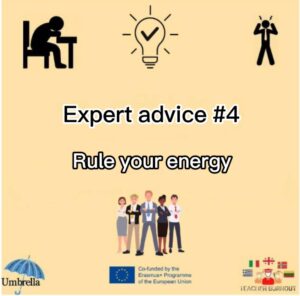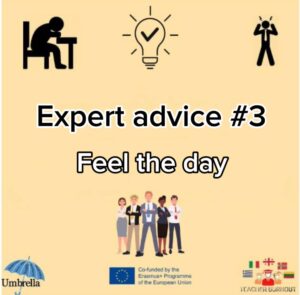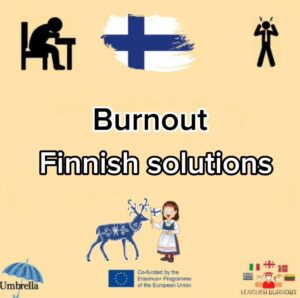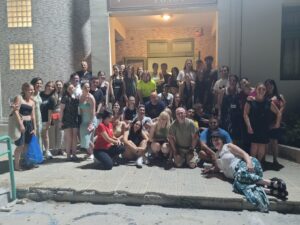Home » 2023 (Page 4)
Yearly Archives: 2023
Expert advice N4

Someone says: In life if you have goals, they have a price tag that includes pain and hard work.
💁♂️ According to today’s “guest” Sadhguru, resilience is a sure way to mess yourself up and complain about everything because you’re doing everything too hard. Once your intelligence is turned against you, no power in the universe can save you. This is a serious mistake. Whole generations have done that: if you study, you should study hard; if you work, you should work hard. Why didn’t they tell you to study joyfully or work “lovingly”. 🥰
🧐 There is substantial medical and scientific evidence to show you only when you’re in a pleasant state of your body and your brain work at their best. So, let’s keep our intelligence working for us and feel blissful.
⚖️ Create Sadhana – Sadhana means doing whatever it takes so that my body, energy, emotions, and thoughts are in my hands. “If you gain mastery over your physical body – the biggest chemistry factory in the world, 15 to 20% of your life and destiny will be in your hands; if you take charge of the very life energies that you have, one hundred per cent of your life and destiny will be in your hands”.
🚫“Everybody thinks their profession is the most difficult one. If any human being is creating something they REALLY CARE for, there will be no burnout; we can work 365 days a year, and we may die from physical exhaustion, but not from burnout or boredom. Those things will never happen to us.”
Teacher bunout Research
Work significantly affects human life and health. Modernisation, along with advantages, also has disadvantages and its own price. It is accompanied by constantly growing stress in all spheres of life. Long-lasting and strong stress results in professional burnout, destroys working motivation and the sense of happiness and luck in life. In that case, the productivity and the quality of service decrease, which induces a great economic damage.
Today, our society and school are looking for the most effective means of implementing the ever-increasing changes in the education system. Special attention is paid to teacher’s profession and personality and specific requirements for the teacher. This causes permanent emotional tension that can lead to teachers’ burnout at work. The studies show that the employees, the essence and content of work of which are frequent and intensive contacts with other people (medical doctors, pedagogues, social workers, managers, etc.) experience strong psychical load, which eventually manifests in emotional distress, loss of interest in the activities, disruptions in communication and deteriorating physical state.
The work stress of a teacher is determined by the specific circumstances of this position and the corresponding workplace. A teacher’s working day usually does not end after leaving the school and the office. The burden of never-ending work and professional worries is inevitably carried by the teacher into the private environment, on days off and even on a teacher’s holyday. It is often much more difficult for a teacher than for representatives of many other professions to combine professional and family roles.
Burnout is a psychological term for the experience of long- term exhaustion and diminished interest. Burnout is a state of emotional, mental, and physical exhaustion caused by excessive and prolonged stress. It occurs when you feel overwhelmed and unable to meet constant demands.
Burn-out is included in the 11th Revision of the International Classification of Diseases (ICD-11) as an occupational phenomenon. It is not classified as a medical condition.
It is described in the chapter: ‘Factors influencing health status or contact with health services’ – which includes reasons for which people contact health services but that are not classed as illnesses or health conditions.
Burn-out refers specifically to phenomena in the occupational context and should not be applied to describe experiences in other areas of life (WHO).
In a chart below, you can see the main differences between burnout and stress:
| Stress | Burnout |
| Characterized by overengagement | Characterized by disengagement |
| Emotions are overreactive | Emotions are blunted |
| Produces urgency and hyperactivity | Produces helplessness and hopelessness |
| Loss of energy | Loss of motivation, ideals, and hope |
| Leads to anxiety disorders | Leads to detachment and depression |
| Primary damage is physical | Primary damage is emotional |
| May kill you prematurely | May make life seem not worth living |
| Work-related causes of burnout | Lifestyle causes of burnout | Personality traits can contribute to burnout |
| Feeling like you have little or no control over your work. | Working too much, without enough time for relaxing and socializing | Perfectionistic tendencies; nothing is ever good enough |
| Lack of recognition or rewards for good work | Being expected to be too many things to too many people | Pessimistic view of yourself and the world |
| Unclear or overly demanding job expectations | Taking on too many responsibilities, without enough help from others | The need to be in control; reluctance to delegate to others |
| Doing work that’s monotonous or unchallenging | Not getting enough sleep | High-achieving, Type A personality |
| Working in a chaotic or high-pressure environment | Lack of close, supportive relationships |
Supriya Jha (2012)
Burnout is a gradual process that occurs over an extended period of time. It doesn’t happen overnight, but it can creep up on you if you’re not paying attention to the warning signals. The signs and symptoms of burnout are subtle at first, but they get worse and worse as time goes on. Think of the early symptoms of burnout as warning signs or red flags that something is wrong that needs to be addressed. If workers pay attention to these early warning signs, they can prevent a major breakdown. If people ignore them, they eventually burn out.
| Physical signs and symptoms of burnout | Physical signs and symptoms of burnout | Physical signs and symptoms of burnout |
| Feeling tired and drained most of the time | Sense of failure and self-doubt | Withdrawing from responsibilities |
| Lowered immunity, feeling sick a lot | Feeling helpless, trapped, and defeated | Isolating yourself from others |
| Frequent headaches, back pain, muscle aches | Detachment, feeling alone in the world | Procrastinating, taking longer to get things done |
| Change in appetite or sleep habits | Loss of motivation | Using food, drugs, or alcohol to cope |
| Increasingly cynical and negative outlook | Taking out your frustrations on others | |
| Decreased satisfaction and sense of accomplishment | Skipping work or coming in late and leaving early |
Supriya Jha (2012)
The research disclosed that special education teachers more frequently experience emotional exhaustion. The research also demonstrated that self-oriented perfectionism correlates with all the scales of job burnout (emotional exhaustion, depersonalization, and personal accomplishment). A multivariate regression analysis showed that such variables as self-oriented perfectionism and age predict 60.3 percent of emotional exhaustion variation (Navaitienė; Danilovienė, 2017).
Even when teachers experiencing burnout stay on, students pay a price. Teachers overwhelmed by stress use less effective teacher strategies. This affects the clarity of their instruction and classroom management. It also results in less stimulating classroom environments. A study in the Journal of Educational Psychology found that teachers experiencing burnout at the beginning of the school year had notably worse classroom management by the spring than other teachers. Their classrooms also suffered from significant student disruptions.
Bubelienė, Merkys (2013) in their research names the further directions of relevant research. It focuses a discussion and recommendations: a) to develop focuses on educational environments in higher education, which would allow to form a hobby for future specialists, b) to develop the recreational infrastructure at universities and schools as in socially responsible organizations, c) to give the status of public value to teachers’ leisure organization and to support this activity.
Teachers who have a hobby and are regularly engaged in it have significantly less expressed symptoms of burnout than those who have no hobbies at all or do have but are little involved in it or are engaged in a hobby very rarely (Bubelienė, Merkys, 2013).
The act of teaching is giving opportunities, ideas, knowledge, and guidance to students. But teacher can’t do this effectively if they are running on empty. Teacher should take care of their needs, balance their life for optimum health, and regularly check in on their own mental wellness. That’s the best system for beating burnout—or avoiding it entirely!
Professional BURN OUT prevention
BIBLIOGRAPHY (Lithuania)
Literatūros sąrašas: (List of literature)
1. Abromaitienė L., Stanišauskienė V. (2014) Profesinis perdegimas karjeros raidos kontekste:
ikimokyklinio ugdymo pedagogų atvejis” Andragogika Nr. 1 (5), p. 10-26. ISSN 2029-6894.
2. Alarcon, G. M. A Meta-Analysis of Burnout with Job Demands, Resources, and Attitude. J.
Vocational Behav. 79 (2), 549–562.
3. Aloe, A., Amo, L. ir Shanahan, M. (2014). Classroom management self-efficacy and burnout:
A multivariate meta-analysis. Educational Psychology Review, 26(1), 101–126.
4. Bakker, A. B. ir Costa, P. L. (2014). Chronic job burnout and daily functioning: A theoretical
analysis.
5. Bulotaitė, L., Lepeškienė, V. Mokytojų stresas ir jo įveikos strategijos. Pedagogika, Nr. 84, p. 48–52
6. Braun S.S. (2020) Effects of teachers’ emotion regulation, burnout, and life satisfaction on student
well-being. Journal of Applied Developmental Psychology.
7. Brouwers A. (2000) A longitudinal study of teacher burnout and perceived self-efficacy in
classroom management” Teaching and Teacher Education.
8. Brouwers, A. ir Tomic, W. (2014). A longitudinal study of relationships between three burnout
dimensions among secondary school teacher. Sensoria: A Journal of Mind, Brain and Culture,
10(2), 23–33.
9. Hartney E. “Stress Management for Teachers“ 2008
https://www.google.lt/books/edition/Stress_Management_for_Teachers/zdS97swqqAMC?
hl=lt&gbpv=1&dq=stress+at+work+teacher&printsec=frontcover
10. Herman K.C., Reinke W.M. “Stress Management for Teachers. A Proactive Guide” 2014.
https://www.google.lt/books/edition/Stress_Management_for_Teachers/2TFFBQAAQBAJ?
hl=lt&gbpv=1
11. Francis D.J., McIntyre S.E., McIntyre T.M. “Educator Stress. An Occupational Health
Perspective“ 2017 https://www.google.lt/books/edition/Educator_Stress/kSIzDwAAQBAJ?
hl=lt&gbpv=1&dq=stress+at+work+teacher&printsec=frontcover
12. Ghanizadeh A., Jahedizadeh S. (2015) Teacher Burnout: A Review of Sources and Ramifications.
British Journal of Education, Society & Behavioural Science 6(1): 24-39, 2015, Article
no.BJESBS.2015.040 ISSN: 2278-0998
13. Gluschkoff, K., Elovainio, M., Kinnunen, U., Mullola, S., Hintsanen, M., Keltikangas-
Järvinen, L. ir Hintsa, T. (2016). Work stress, poor recovery and burnout in teachers. .
Occupational Medicine, 66(7), 564–570.
14. Grigaliūnaitė R., Pečiuliauskienė P. Specialiųjų pedagogų saviveiksmingumas ir perdegimo
sindromas.
15. Kim, L. E., Jörg, V., & Klassen, R. M. A meta–analysis of the effects of teacher personality on
teacher effectiveness and burnout. Educational psychology review, 31(1), 163– 195
16. Lee, Y., and Lee, J. Enhancing Pre-service Teachers’ Self-Efficacy Beliefs for Technology
Integration through Lesson Planning Practice. Comput. Educ. 73, 121–128.
17. Malinauskas, R. (2008). Sporto pedagogų perdegimo ypatumai. Ugdymo psichologija, 19, 68–73.
18. Madigan D. J., Kim L.A. (2021)Does teacher burnout affect students? A systematic review of its
association with academic achievement and student-reported outcomes. International Journal of
Educational Research Vol. 105, 2021, 101714
19. Madigan, D., Stoeber, J. ir Passfield, L. (2016). Motivation mediates the perfectionism–burnout
relationship: A three-wave longitudinal study with junior athletes. Journal of Sport and Exercise
Psychology, 38(4), 341–354.
20. Murauskaitė K. “Lietuvos pagrindinio ugdymo pedagogų profesinio perdegimo veiksniai”.
21. Navaitienė J., Danilovienė V. (2017) Mokytojų perdegimas darbe ir perfekcionizmas. Ugdymo
psichologija Educational Psychology 2017, t. 28, p. 38–55 / Vol. 28, pp. 38–55,
22. Pressley T., Marshall D.T., Moore T. Understanding Teacher Burnout Following COVID-19.
Psychology, Newport News, VA 23606.
23. Seidman, S. A., Zager Z. (1986) The Teacher Burnout Scale.” Educational Research Quarterly 11,
no. 1: 26-33
24. Scherer, R. The Importance of Attitudes toward Technology for Pre-service Teachers’
Technological, Pedagogical, and Content Knowledge: Comparing Structural Equation Modelling
Approaches. Comput. Hum. Behav. 80, 67–80.
25. Stoškus A. (2011) Kūno kultūros mokytojų profesinio perdegimo ypatumai. Klaipėdos
universitetas ISSN 1392-3137. TILTAI, 2011, 3
26. Stočkus, A. (2014). Kūno kultūros mokytojų profesinio perdegimo prevencija ir redukavimas:
ugdomojo projekto rezultatai. Tiltai, 1, 151–168.
27. Šimkutė S. Kokie bruožai būdingi pedagogo profesinio perdegimo sindromui?
(svietimonaujienos.lt)
28. Ullrich A., McCarthy C.J., Lambert R.G. (2012) International Perspectives on Teacher Stress.
https://www.google.lt/books/edition/International_Perspectives_on_Teacher_St/hwIoDwAAQBAJ?
hl=lt&gbpv=1
29. Thom J. (2020) Teacher Resilience Managing Stress and Anxiety to Thrive in the Classroom.
30. Zakaitis P., Purkoonenė J. (2007) Pedagogų pasitikėjimo savimi ir perdegimo raiškos sąsajų
ypatumai. Klaipėdos universitetas Ugdymo psichologija. Nr. 18, p. 46-54
Expert advice N3

Hi
Today, Umbrella is sharing with you the ideas and thoughts of Brandon Burchard, the world’s highest-paid motivational and marketing trainer and one of the most influential leaders in the field of personal growth.
Here you are:
Feel The Day- If we were talking about successful people, what everybody wants after getting everything. After you hit your goals, you make the money you feel like your family needs. What you want is you want to feel the day more. You want greater depth in your relationships, like deeper relationships, more profound commitment, and deeper meaning, right?
The whole mindfulness movement is really architected. I want to feel the day; I want to feel a presence. I want to feel the energy. I want to feel the spirit. I want self-awareness or consciousness.
Pit Stops throughout the day are essential for feeling the day. You need to have moments that you purposely take every day throughout the day to reconnect with spirit, soul, energy, or even to breathe.
I stand, I close my eyes, and I bounce in place. I take 10 deep breaths & it re-energizes my body and my brain. My mental focus is back. When I open my eyes, I wonder what’s my intention for this next hour. And that little pit stop makes me go longer. You need little more pit stops to tune your mind, amp up your emotions, and reconnect with the heart, the spirit or the soul. If you are grinding all day, that’s the equation for burnout. You cannot possibly hope the burnout will end if you don’t do more consistently recharge.
The world’s most extensive study of productivity that’s ever been done found that the most productive people also reported high levels of happiness. They took a break, on average, every 52 minutes. Did they need a break? No, they’re recharging. If you’re crashing at 2pm in the afternoon every day, it’s time to take a hint. You need to recharge at 10:30 or 1:30 to prevent the crash that happens at 2 p.m. The crash is happening because the recharges are not happening.
Expert advice N2

💁♂️ Our today’s “guest”, Dr Lukin, explains five ways to prevent burnout from happening through Cognitive Behavioral Therapy (CBT).
💭 Realize your thoughts and feelings are not facts – just because you have an idea or a sense, it does not make it so. So being aware and putting it in context of what’s happening in your life allows for a person to better cope with the T&F that are coming up. Non-attached observation of a T&F invariably decreases the intensity of any destructive emotion.
🌿 Get up and do something physical – routinely getting up and moving, going for a walk or having lunch in a green area improves one’s ability to tolerate stress.
📵 Consider your time spent on smart devices – many apps nowadays focus on mindfulness and meditation; engaging in some reflections via those apps rather than mindlessly browsing through FB or Twitter is an excellent way to reduce your burnout.
🧐 Reconnect to your “why” – People usually forget why they are doing their job. Spending some time reflecting on why you got into the field reinvigorates the individual to continue the work, so make notes to remind yourself why you started it.
👨👩👦 Reach out to loved ones – loneliness is another reason, not even so much that the individual is having a hard time dealing with anxiety, depression, are feeling overwhelmed. The idea is that they are doing it alone. So sending a simple message or spending time with loved ones helps reconnect to the greater context of why they are doing certain things and allows for a better opportunity for individuals to self-care and manage some burnout stress.
🫡 Try to pick one of the pieces of advice and put it into practice relatively consistently. Don’t feel discouraged if you’re not doing it consistently a 100% accuracy. These are just some ideas to think about, to put in your toolbox and take out whatever you are feeling stressed.
Expert advice N1

Hi dear friends! ☂️
💁♂️ We back with unusual ways to slow down and deal with burnout.
🔥 Recognise that passion makes you more vulnerable to burnout
In the self-help classic, The Monk Who Sold His Ferrari, Robin Sharma writes: “A burning sense of passion is the most potent fuel of your dreams”. You’ve heard it before – if you do what you love, you’ll never work a day. 🗣But at the same time, entrepreneurs are no strangers to this. This explains why the term ‘entrepreneurial burnout’ has been coined and attributed to a mistaken belief that following your passion means sacrificing everything at hand.😓
👉 David Whiteside, who holds a PhD in organisational behaviour, explains: “Despite the clear benefits of feeling meaningfully connected to your work, our data suggests that there are often real and undiscussed complications of purpose-driven work on employees’ health that can be related to the experience of burnout long-term”.
💭 Embrace ‘niksen’ (the Dutch art of doing nothing)
Niksen – doing something without a purpose, like sitting still, daydreaming or staring out the window. It’s forcing your mind to be idle, to have no intentions.
📃 In her article for Forbes, The Fastest Way to be More Productive is to Slow Down, Amy Blaschka writes: “Research has found that when we’re idle, we allow our minds to wander. And that daydreaming makes us more creative, better at problem-solving and better at coming up with creative ideas”.
✍️ She continues: “Our culture does not promise sitting still, and that can have wide-reaching consequences for our mental health…Practising niksen can recharge our batteries”.🔋👍
Recognise burnout as a workplace problem, not a people problem, author and workplace expert Jennifer Moss suggests a good place to start: “First, ask yourself as a leader, what is making my staff so unhealthy? Why does our work environment lack the conditions for them to flourish?”.👩💼
Finish solution.

You may agree that it’s hard to put happiness into numbers but every year the World Happiness Report puts out a very beefy breakdown of happiness around the world.
The report, which draws on global survey data from people in around 150 countries placed Finland in the top position for the sixth year in a row, with a happiness score significantly ahead of all other countries.
Are you curious about how Finnish people deal with burnout? Let’s take a look together:
– The Finns take their summer holidays seriously. After enduring long bouts of cold weather and darkness in winter, the Finns enjoy their summers usually spending time in nature. Striking a balance between work and life goes hand-in-hand with efficiency.
– Some ranchos in Finland offer goat therapy sessions. Humans interacting with animals have found that petting the animal promoted the release of serotonin, prolactin and oxytocin-all hormones that can play a part in elevating moods it also lowers anxiety, helps people relax, provides comfort and reduces loneliness.
– For those working in cities like Helsinki companies provide sleeping places with wooden pillows and unique chairs for sleeping in feet put up position.
– Finnish sauna – the relaxation brought by sauna bathing makes it a brilliant stress repellent and enhancer of sleep quality. It lifts up spirits even in a depressed mood. The brain also gets its own share of the soft caress: which prevents memory disorders, such as Alzheimer’s disease.
Other content from this project:
Indian solutions – https://cutt.ly/vwthAYAL
USA solutions – https://cutt.ly/rwwSg5Bh
Spanish solutions – https://cutt.ly/GwqwWHYh
Japanese solutions – https://cutt.ly/d54QT48
What is burnout? – https://cutt.ly/AwqPuFyb
Project announcement – https://cutt.ly/l4EPrM2
The project is supported by the European Commission within the scope of the Erasmus+ program.
https://www.instagram.com/p/Cts-HzNIHwO/
https://www.facebook.com/photo/?fbid=644367401057883&set=a.554912253336732
Not all heros wear capes

During the devastating fires on the island of Rhodes in July 2023, the 4th GEL Rhodes opened its arms to host tourists from the hotels of the evacuated areas. Teachers, parents, students and alumni of the school joined forces to ease the suffering of the fire victims and ensure them the best possible accommodation and feeding conditions until they return to their countries or continue their vacation.
As a tourist who was hosted at the school said “not all heros wear capes”!











